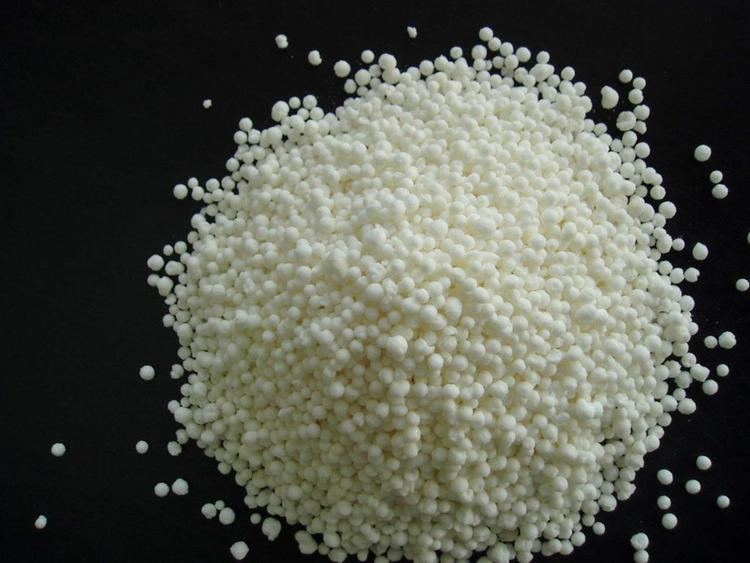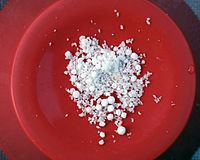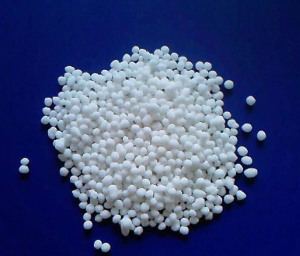Appearance white/grey solid Formula (NH4)(NO3) Melting point 169.6 °C Soluble in Water | Related compounds Molar mass 80.043 g/mol Density 1.72 g/cm³ Boiling point 210 °C | |
 | ||
Ammonium nitrate
Ammonium nitrate is a chemical compound, the nitrate salt of the ammonium cation. It has the chemical formula NH4NO3, simplified to N2H4O3. It is a white crystal solid and is highly soluble in water. It is predominantly used in agriculture as a high-nitrogen fertilizer. Its other major use is as a component of explosive mixtures used in mining, quarrying, and civil construction. It is the major constituent of ANFO, a popular industrial explosive which accounts for 80% of explosives used in North America; similar formulations have been used in improvised explosive devices. Many countries are phasing out its use in consumer applications due to concerns over its potential for misuse.
Contents
- Ammonium nitrate
- 04 writing ionic formula ammonium nitrate
- Occurrence
- Production
- Reactions
- Crystalline phases
- Fertilizer
- Explosives
- Mixture with fuel oil
- Terrorism
- Niche uses
- Safety handling and storage
- Health hazards
- Disasters
- References
04 writing ionic formula ammonium nitrate
Occurrence

Ammonium nitrate is found as a natural mineral (ammonia nitre—the ammonium analogue of saltpetre and other nitre minerals such as sodium nitrate) in the driest regions of the Atacama Desert in Chile, often as a crust on the ground and/or in conjunction with other nitrate, chlorate, iodate, and halide minerals. Ammonium nitrate was mined there in the past, but virtually 100% of the chemical now used is synthetic.
Production
The industrial production of ammonium nitrate entails the acid-base reaction of ammonia with nitric acid:
HNO3 + NH3 → NH4NO3
Ammonia is used in its anhydrous form (i.e., gas form) and the nitric acid is concentrated. This reaction is violent owing to its highly exothermic nature. After the solution is formed, typically at about 83% concentration, the excess water is evaporated to an ammonium nitrate (AN) content of 95% to 99.9% concentration (AN melt), depending on grade. The AN melt is then made into "prills" or small beads in a spray tower, or into granules by spraying and tumbling in a rotating drum. The prills or granules may be further dried, cooled, and then coated to prevent caking. These prills or granules are the typical AN products in commerce.

The ammonia required for this process is obtained by the Haber process from nitrogen and hydrogen. Ammonia produced by the Haber process is oxidized to nitric acid by the Ostwald process. Another production method is a variant of the Odda process:
Ca(NO3)2 + 2 NH3 + CO2 + H2O → 2 NH4NO3 + CaCO3The products, calcium carbonate and ammonium nitrate, may be separately purified or sold combined as calcium ammonium nitrate.
Ammonium nitrate can also be made via metathesis reactions:
(NH4)2SO4 + Ba(NO3)2 → 2 NH4NO3 + BaSO4NH4Cl + AgNO3 → NH4NO3 + AgClReactions
Ammonium nitrate reacts with metal hydroxides, releasing ammonia and forming alkali metal nitrate:
NH4NO3 + MOH → NH3 + H2O + MNO3 (M = Na, K)Ammonium nitrate leaves no residue when heated:
NH4NO3 → N2O + 2H2OAmmonium nitrate is also formed in the atmosphere from emissions of NO, SO2, and NH3, and is a secondary component of PM10.
Crystalline phases
Transformations of the crystal states due to changing conditions (temperature, pressure) affect the physical properties of ammonium nitrate. These crystalline states have been identified:
The type V crystal is a quasicubic form related to caesium chloride, the nitrogen atoms of the nitrate anions and the ammonium cations are at the sites in a cubic array where Cs and Cl would be in the CsCl lattice.
Fertilizer
Ammonium nitrate is an important fertilizer with the NPK rating 34-0-0 (34% nitrogen). It is less concentrated than urea (46-0-0), giving ammonium nitrate a slight transportation disadvantage. Ammonium nitrate's advantage over urea is that it is more stable and does not rapidly lose nitrogen to the atmosphere. During warm weather it is best to apply urea soon before rain is expected or to cover it with soil to minimize nitrogen loss.
Explosives
Ammonium nitrate is not, on its own, an explosive, but it readily forms explosive mixtures with varying properties when combined with primary explosives such as azides or with fuels such as aluminum powder or fuel oil.
Mixture with fuel oil
ANFO is a mixture of 94% ammonium nitrate ("AN") and 6% fuel oil ("FO") widely used as a bulk industrial explosive. It is used in coal mining, quarrying, metal mining, and civil construction in undemanding applications where the advantages of ANFO's low cost and ease of use matter more than the benefits offered by conventional industrial explosives, such as water resistance, oxygen balance, high detonation velocity, and performance in small diameters.
Terrorism
Ammonium nitrate-based explosives were used in the Oklahoma City Bombing in 1995 and 2011 Delhi bombings, the 2013 Hyderabad blasts, and the 2011 bombing in Oslo.
In November 2009, a ban on ammonium sulfate, ammonium nitrate, and calcium ammonium nitrate fertilizers was imposed in the former Malakand Division—comprising the Upper Dir, Lower Dir, Swat, Chitral, and Malakand districts of the North West Frontier Province (NWFP) of Pakistan—by the NWFP government, following reports that those chemicals were used by militants to make explosives. Due to these bans, "Potassium chlorate — the stuff that makes matches catch fire — has surpassed fertilizer as the explosive of choice for insurgents."
Niche uses
Ammonium nitrate is used in some instant cold packs, as its dissolution in water is highly endothermic. It also was used, in combination with independently explosive "fuels" such as guanidine nitrate, as a cheaper (but less stable) alternative to 5-aminotetrazole in the inflaters of airbags manufactured by Takata Corporation, which were recalled as unsafe after killing 14 people.
Safety, handling, and storage
Health and safety data are shown on the safety data sheets available from suppliers and found on the internet. In response to several explosions resulting in the deaths of numerous people, U.S. agencies of Environmental Protection (EPA), Occupational Health and Safety (OSHA) and the Bureau of Alcohol, Tobacco and Firearms jointly issued safety guidelines.
Heating or any ignition source may cause violent combustion or explosion. Ammonium nitrate reacts with combustible and reducing materials as it is a strong oxidant. Although it is mainly used for fertilizer, it can be used for explosives. It was sometimes used to blast away earth to make farm ponds. Ammonium nitrate is also used to modify the detonation rate of other explosives, such as trinitrotoluene in the form of amatol.
Numerous safety guidelines are available for storing and handling ammonium nitrate. It should not be stored near combustible substances. Ammonium nitrate is incompatible with certain substances such as chlorates, mineral acids and metal sulfides, contact with which can lead to vigorous or even violent decomposition.
Ammonium nitrate has a critical relative humidity of 59.4%, above which it will absorb moisture from the atmosphere. Therefore, it is important to store ammonium nitrate in a tightly sealed container. Otherwise, it can coalesce into a large, solid mass. Ammonium nitrate can absorb enough moisture to liquefy. Blending ammonium nitrate with certain other fertilizers can lower the critical relative humidity.
The potential for use of the material as an explosive has prompted regulatory measures. For example, in Australia, the Dangerous Goods Regulations came into effect in August 2005 to enforce licensing in dealing with such substances. Licenses are granted only to applicants (industry) with appropriate security measures in place to prevent any misuse. Additional uses such as education and research purposes may also be considered, but individual use will not. Employees of those with licenses to deal with the substance are still required to be supervised by authorized personnel and are required to pass a security and national police check before a license may be granted.
Health hazards
Health and safety data are shown on the material safety data sheets, which are available from suppliers and can be found on the internet.
Ammonium nitrate is not very hazardous to health and is usually used in fertilizer products.
Ammonium nitrate has an LD50 of 2217 mg/kg, which for comparison is about two-thirds that of table salt.
Disasters
Ammonium nitrate decomposes into the gases nitrous oxide and water vapor when heated (not an explosive reaction); however, it can be induced to decompose explosively by detonation. Large stockpiles of the material can be a major fire risk due to their supporting oxidation, and may also detonate, as happened in the Texas City disaster of 1947, which led to major changes in the regulations for storage and handling.
Two major classes of incidents resulting in explosions are:
